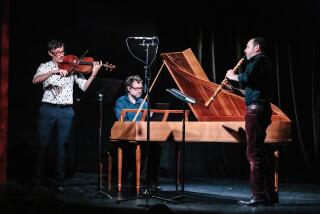2 Jazz Festivals Serving Up a Big Dose of Music in L.A.
For Chuck Conklin, the executive director of the fifth annual Los Angeles Classic Jazz Festival, the hard part is over. For William Coffey, who heads the fledgling LA Jazz ’88 festival, the hard part is just beginning.
Conklin’s festival, which runs today through Monday at the Airport Marriott and Hilton hotels, is on financially solid ground and has become a major traditional jazz event.
“We’re expecting about 25,000 people over the weekend,” said Conklin, a 56-year-old part-time cornetist and film sound technician. The festival--which is run under the aegis of the nonprofit United Jazz Clubs of Southern California--is almost sold out.
Coffey’s festival, which consists of two shows, the first a free Saturday concert at MacArthur Park and the second Sunday at the Shrine Auditorium, is sponsored by the International Assn. of Jazz Appreciation. Coffey, president of the international association, says getting a jazz festival going is no piece of cake.
“It’s tough,” said the 56-year-old dermatologist who has donated about 25 hours a week to the international association’s activities since he founded it six years ago.
Money is Coffey’s main concern. The international association sought corporate sponsorship for the festival, which, with its Sunday concert, celebrates the 217th anniversary of the founding of this city.
But Coffey said corporations wanted to make sure the City of Los Angeles would also support the event with grant money before commitments could be made. “That approval, in the form of a letter from Mayor Bradley’s office, didn’t arrive in IAOJA hands until February of this year, and by then, corporate budgets had been finalized,” said Coffey.
If “corporate America” didn’t come through, the city did. “We’re getting funds in little bits and pieces,” Coffey said, including $5,000 from the Los Angeles Cultural Affairs Department (an additional $15,000 is reportedly pending), “as well as individual loans from IAOJA members.”
The problem with a shortage of seed money is that the international association can’t promote its concerts the way it would like to. “I don’t know how we’ll do,” Coffey said, “but you have to take a step. Of course, I hope we do well. Very few ventures and businesses start off being monetarily successful. It usually takes time, so we’re focusing down the road. We want to make this an annual event.”
Conklin knows about money hassles: “We lost $40,000 our first year and I had to take out a second mortage on my house to cover the debt. But by the third year, we had turned things around enough to pay that off, and with the funds left over from last year, we had seed money to start this year.”
The two festivals kick off a month of major league jazz activities in Los Angeles, with appearances by such front-line artists as John Abercombie, Ahmad Jamal, Doc Severinsen’s Tonight Show Orchestra, Kenny Burrell, J.J. Johnson and McCoy Tyner, culminating with the seventh annual Jazz Times Convention, which will be Oct. 5-8 at the Sheraton Universal in Universal City.
Distinct styles of jazz are spotlighted in the two events. The Classic Jazz Festival, as its name implies, “includes anything from ragtime to swing, from 1900 to 1950,” said Conklin. “We try to give listeners what they won’t hear at (other major jazz festivals such as) Playboy or Monterey.” Among the players on tap are clarinetists Pete Fountain and Abe Most, trumpeters Dick Cathcart and Jack Sheldon and trombonist Roy Williams, the latter in from London.
LA Jazz ’88 likewise features local and out-of-town artists, but of the modern genre, including orchestras led by Gerald Wilson and Buddy Collette (see related story by Leonard Feather) and small groups led by Nat Adderley, James Moody, Poncho Sanchez and Oliver Jones. Coffey would like a more comprehensive program.
“Although our talent is outstanding, I’m disappointed we’re still not able to demonstrate all the facets of jazz,” he said. “Be-bop fans should be able to listen to fusion and gospel. It all stems from the same root.”
Conklin and Coffey count on volunteer help to bring their affairs off, and the people who offer their time do so with a willing spirit. Conklin recruited about 300 volunteers; Coffey about 35.
“It’s very satisfying,” said Beatrice (Peach) Holmes, one of 20 regular staffers who put on the Classic Jazz Festival. “Once you get caught up in the whole camaraderie of all these other people doing, you get so you don’t want to stop. It’s kind of a let down when the festival’s over.” For Ruth Roby, executive director of the international association, the reward is “in a job well done. Of course, I believe in what IAOJA does, which is jazz education.”
The international association sponsored a Jazz Goes to School program this year, where it offered a jazz appreciation course, including live performances, in 25 schools for students from kindergarten through high school. The United Jazz Clubs of Southern California hopes to initiate a jazz seminar program this year.
Despite the work involved, Conklin and Coffey enjoy their avocations as jazz organizers and advocates. “It’s a good way to promote and preserve one of America’s true contributions to the arts,” said Conklin.
“I was politically active in medicine,” Coffey said, “but medicine will always have its advocates, and jazz needs help. I decided if I’m going to volunteer time, I want it to be for something that needs me and that I’m really interested in. And I love jazz.”
More to Read
The biggest entertainment stories
Get our big stories about Hollywood, film, television, music, arts, culture and more right in your inbox as soon as they publish.
You may occasionally receive promotional content from the Los Angeles Times.










